The Automobiliac goes to Racing School Part 2
 Tuesday, July 27, 2010 at 10:12PM
Tuesday, July 27, 2010 at 10:12PM Way back in May, I ran Part One of my account of going to Skip Barber racing school. It took me a while to finish it and edit the video footage, but here is the long-promised Part Two!
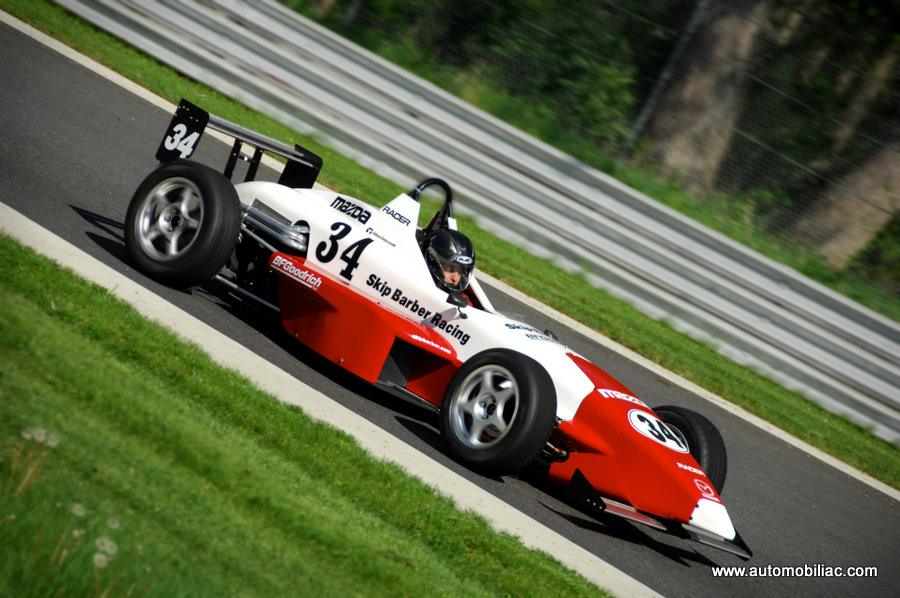
DAY 2
After a good night’s sleep, I awoke the second day and looked outside. The ground was wet, but it appeared not to be raining. In this part of Connecticut, the mornings are usually damp, but the moisture quickly burns off as the sun comes out and warms up the ground. After a breakfast that I ate in haste --I always have trouble enjoying my food when I am full of nervous energy--I drove to the track, again enjoying the marvelous views and smells of the lush greenery. Arriving at the track, we started the day with some classroom time. One of the quirkiest aspects of the classroom sessions is how many different acronyms you have to remember. There’s TTO (trailing throttle oversteer) CPR ( Correction, Pause, Recovery) and my favorite of all was the admonition to stay off the FGR (the Friggin Guard Rail). On the first day, R.B. had given us a rather amusing lecture about the importance of locking up all wheels once you have definitively lost control (“When you spin, both feet in”). This allows your car to move in a predictable way so that the next guy behind you knows exactly where your car is going and can take evasive action. But R.B. made it clear that it was best to stay on the track as much as possible. “Because,” he said, pausing in his whiteboard diagram to draw in the inner and outer guardrails, “outside the track….there’s stuff.”
Now, notice I never mentioned doing any braking exercises in part one. That’s because paradoxically, we didn’t focus on that skill until now. "Threshold Braking" is an art form that has become largely outmoded in the top echelon of motor racing due to the use of advanced ABS and stability control systems. But in our comparatively primitive cars, we practiced braking at the last possible instant (at a cone placed on the front straight) as hard as possible. Then, just as the front tires were on the verge of lockup, we had to learn to modulate brake pressure. The goal here was to come to a complete stop in the shortest possible distance with minimal tire smoke, and without flat-spotting the tires. I had a lot of fun with this exercise and got the hang of it quicker than I expected. But then they upped the ante.
Now, instead of threshold braking in a straight line, we had to do it as we started the corner’s entry. This meant trying to turn and brake at the same time. I had some serious mess-ups here, including accidentally hitting the gas and brake simultaneously, which is a common problem in beginners due to the confined footwell. Rob looked down at me with a neutral expression, as I sat in the cockpit sheepishly. “Do you know what you did wrong?” he said. I nodded and admitted my folly, and it was back to try again. I started to figure it out, but was pretty glad when the exercise was over.
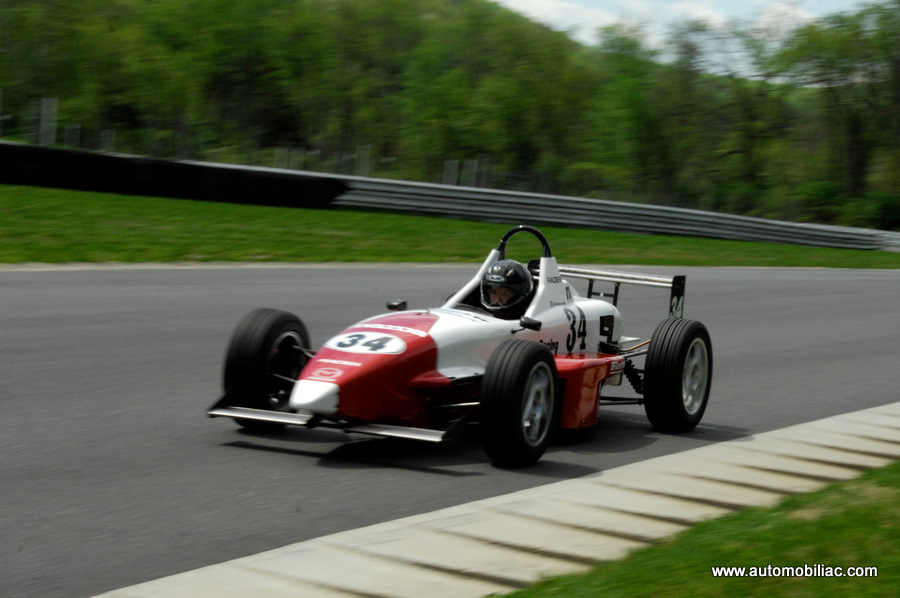
The next exercise entailed outbraking a phantom opponent’s car. The instructors set up a cluster of cones right before the chicane to represent the other car. That they called the cluster of cones “Danica,” and told us, “now imagine you are making a pass on Danica” –which had the desired effect of causing the entire classroom to break out in peals of laughter. The idea was to imagine you are following Danica all the way down the back straight, right on her tail, as it were. Then, just as the braking zone is reached, you were to pull out, so to speak, from behind her draft and brake alongside her (the cone cluster), then turn into the correct racing line.
So we got in the cars and tried our best to make a successful pass on Danica. This is what you can see in the video clip. You’ll notice a cluster of cones to the left of the track at the entry of the chicane. I have to say now I was really starting to get a great feeling in the car. The initial nerves I had were wearing away, and now that we had done the braking exercises, I really started to feel like I could push it. Plus, we were now not limited in our revs for most of the lap. So hurtling down the back straight around 90mph and braking down from 4th to 2nd gear while blipping the throttle was just about heaven. I felt like I was really driving a racing car now! Feeling my body press into the harness under threshold braking was an awesome feeling that I had never experienced before in a road car. That combined with the sound of the engine as I snicked down two gears, careened through the chicane, then blasted up the hill at full throttle was nothing short of intoxicating. I started to try braking later and later, and soon I found myself getting the tail a little loose in the entry and had to correct with opposite lock. At my next appointment with the Stop Box, Rob playfully admonished me via radio “Bradley, your hair is not on fire! You don’t need to drive like it is. Just calm down and try to do the exercise precisely and cleanly.”
While group 2 was doing their exercise, and we were out of the cars, we drove with the instructors to various vantage points on the track to watch. At this point, we noticed a rather threatening cold front moving in over the hills. We debated the meaning of this approaching cold front, but as group 2’s session came to a close, the meaning became clear as the wind began to pick up in a major way. Quietly, we got in the cars for our turn as rain began to fall. As I pressed the starter button, I saw a fork of lighting over the hills and thought to myself…this is probably a bad idea. Now, the cockpit is warm and cozy enough that a little rain is not a big deal, but by the time we left the pits, the rain was coming down hard and fast, and the gusty wind was now blowing sticks and leaves across the pavement. I said to myself “Ok, buddy just take it easy. Try to remember the wet line they showed us yesterday.” The cars were spaced out enough that driving in a wall of spray was not an issue. But I was on tenterhooks the whole time, recalling how easily the car came unstuck yesterday on the wet track. All of the bravado I had mustered in the previous session ebbed away leaving behind a feeling of hyperfocused concern. After my first lap was over, I started to relax a tiny bit, because I had now at least seen the conditions at each point in the track. But as I came out of the right hander onto the back straight, I felt tiny pin prickly feelings on my chest and shoulders. Small white dots began to burst into liquid form on my visor, and I realized I was driving through hail!
“You guys really wussed out this time,” Bruce and R.B. agreed when we got out of the cars soaking wet and grateful to be alive. It was true. Rather than take this as an opportunity to really see what was possible in the rain, all of us, myself included, had basically just driven around the track like we were in a Rose Bowl parade. But self preservation is a strong instinct that has to be kept in check sometimes if you really want to go fast. And I don’t think any of us had come close to achieving that control yet. As I drove home that evening, I was shocked at the amount of downed trees and other mayhem the tempest had caused. And I concluded that wuss or no wuss, it was good to be home safe.
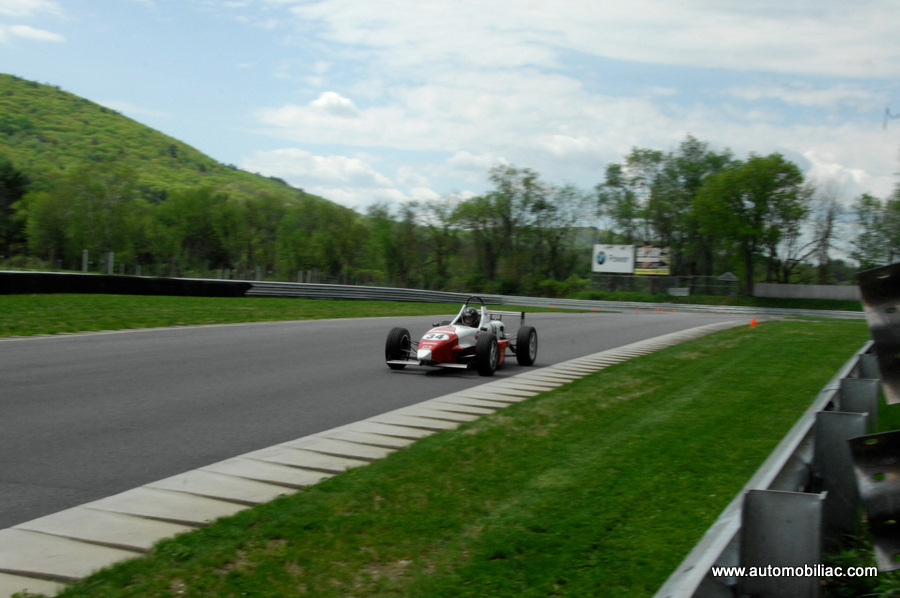
Day 3
The last day was about as perfect as you could really ask for in the Berkshires. The previous day’s storm had cleared the way for a brilliantly cloudless blue sky. Today was the last day of classes, and we would finally get to do open lapping with no rev limit! I reflected on my previous two days, and couldn’t believe how much progress I had made. And not just me; all my classmates had really gotten comfortable in the cars too. Some were faster than others, but I had to sort of marvel at the Skip Barber method because on the face of it, it seems sort of crazy to let ordinary people loose in race cars after just 2 days of training. Now, maybe my class was more disciplined than average, but I knew we’d all do just fine when we got out on the track by ourselves. Now since this article has gotten pretty long, I’ll just skip ahead to the good part.
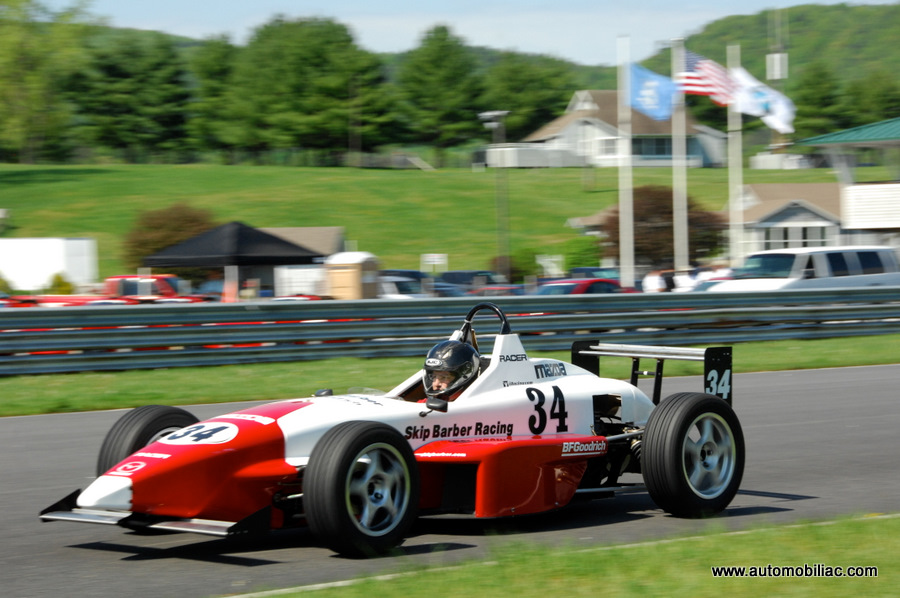
When it came time, each group had two open sessions out on the track. I tried to savor every moment. For the first session, I had a camera mounted on my rollbar, so the video attached is my best lap from the first session. My laptime was a 1:06.4. Now, I am hoping I was a tad faster in the second session, but even if I wasn’t, I am still content with this level of accomplishment for my first time. To put this in perspective, the pole time at a recent Skip Barber race using these same cars was something in the low 57s, but they were racing on slicks, not the BF Goodrich road tires I was using. So am like 9 or 10 seconds off that pace. Which is pretty good for a novice, but is an eternity in racing terms.
Driving the race car as fast as I could was to oscillate between feeling of complete control, and slight intimidation. In the slower section at the beginning of the lap, I was putting the car through the corners really hard, feeling a lot of lateral g-force in the corners (if you don’t believe me, look at the G-meter in the lower right corner) and generally feeling very comfortable to the extent that I felt like I was driving a big go-kart, and I was driving close to the real limit of the car’s adhesion. But once the car was stretching its legs down the back stretch, I had to really test my faith in the car’s grip as I went into the uphill, and I never really felt like I could drive the faster sections at 10/10ths because it just was too uncertain at my experience level. I could sense that there was more time there, and I could feel myself holding back. But it just takes a certain amount of comfort and experience to reach out and grab those extra seconds that I just didn’t have yet. Now let me just say, the uphill is one of the most challenging parts of the track. The first 2 days, the uphill was blocked off, and we were driving through a chicane instead (as you see in the video). But since we were “big boys” now, they had us take the uphill at racing speed. Basically, you enter the corner fairly early after some moderate braking and you have to accelerate through the apex at around 70mph and up the hill despite the fact that you can’t actually see where the car is going to end up. Add to this the close proximity of the guardrail (FGR) at the exit and you can see why I swallowed a bit harder each time I planted my foot on the gas pedal in this spot. As the car takes a set, you feel like you are taking off in a small plane. The car carries itself up the hill, and all you can see is the brow of the hill, and the blue sky. This is a good moment to contemplate religion. As you crest the hill, you feel momentarily weightless, and you can see all the travel of the front suspension go slack in front of you, just for an instant. But then the car comes back down and the suspension compresses, and you blast off down the next straight into West Bend. Judging the exact amount of braking for West Bend is tricky because it is a fast 4th gear corner taken around 75mph, and the temptation is to slow down more than you really have to. The exit of West Bend tracks you out right towards a very solid and unmovable bridge embankment, and at this point, you enter a downhill section that is way steeper than it looks, which sets you up for the final bend that leads into the front straight. Again, the temptation here is to brake earlier and/or harder than necessary because you carry a lot of speed down that hill, but you need a dab on the brakes to shift the car’s balance to its nose so that you can turn in definitively and apply power before the apex to maximize your exit speed. Exit speed here is absolutely crucial because of the long straight following the corner. Again though, I knew I was braking a little more than I should in the entry, but it was just a little too soon to be brave, as I was already entering the corner at over 90mph, dipping to around 85 at the apex. I was reaching around 113mph by the time I braked for the first corner at the end of the long front straight.
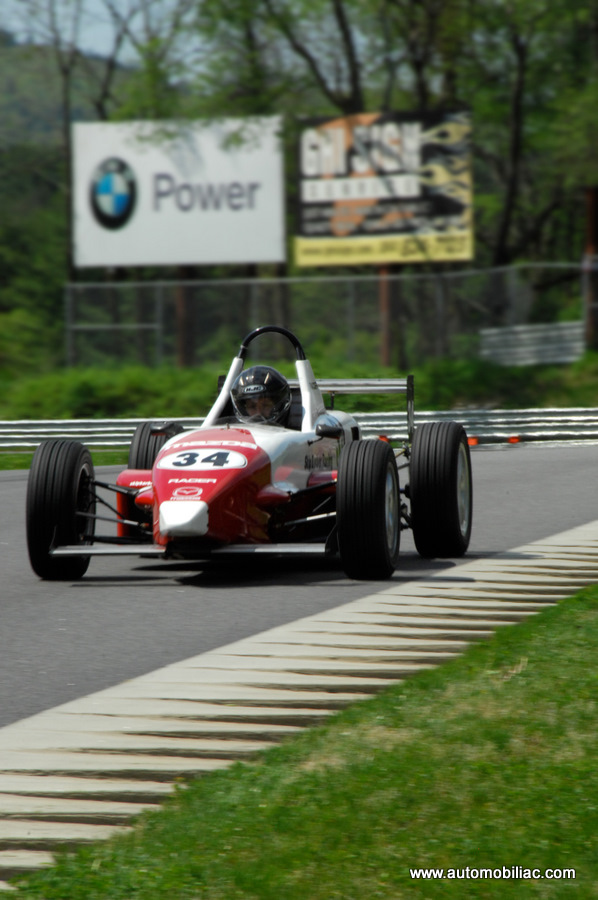
It’s true what is often said about racing, that it makes you feel more alive. The wonderful aroma of the infield’s freshly cut grass wafted into my helmet even though I hadn’t smelled it while standing still. It really was a natural high, and once I got situated, I think I felt more relaxed than tense. As the second session came to an end, and I slowed to enter the pits for the last time, the realization that my 3 days at racing school were over started to wash over me. I had savored every moment as much as I could, but the realization that my euphoria was to be over for the foreseeable future was bumming me out we I finally came to a halt and killed the engine. We had a nice diploma session in the classroom and talked about what we had learned, then everybody climbed into their cars and returned to being ordinary motorists.
 Lime Rock,
Lime Rock,  Racing School,
Racing School,  Skip Barber in
Skip Barber in  Musings
Musings 
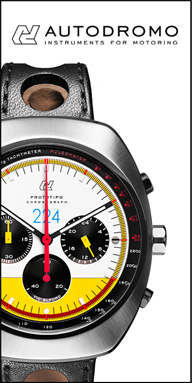
Reader Comments (4)
That really looks like the most unbelievable fun. I know the course very well from many visits as a spectator and also from a couple of slow laps in an XK120 when Lime Rock and I were both young. So, some questions: What does your 1:06+ translate to in average mph? By how much do you think you could better your time after another 3-day session? How fast should you be going, or were you going, in the first turn after 130 mph in the straight? and in which gear? Are you supposed to make one very quick change of direction in the middle of the tight left-right S? (It looks right to me, and it looks like that's what you did.) Is the downhill part after you go under the bridge as scary as it looks, or does that wear off after a few laps? Where on the course did you drift, if at all? Your descriptions and on-board video are excellent, but one still has questions.
That's a loooot of questions. My average speed calculates to 85 mph, given a 1.53 circuit length. I think I can definitely knock a few seconds off my time simply by braking later into turn one, and getting comfortable carrying more speed through the uphill and west bend, as well as the final corner. I could sense that I was holding back. I was not driving balls to the wall, mainly out of fear. The sense that more time is out there for the taking was palpable to me. In other words, i was not driving as fast as I could (like in a video game where there are no consequences). I was driving as fast as was comfortable at this point of my confidence. In the left-right S, you need to take a very late turn-in for the left-hander so that you can hug the kerb and be ready to turn into the right hander and squeeze on the power as early as possible. I tried to do this, but you can see a slight correction I made mid-corner in the right hander. This was because I turned in slightly too sharply and abruptly and this spoiled my line. Yet oddly this was my fastest recorded lap. The downhill part is really really scary. It is waaaay steeper than it looks, and you need to fight all your instincts to slow down. Much of going fast is fighting your self-preservation instincts, I find. I was not drifting anywhere really. I didn't have enough confidence to push the car past its limit of adhesion. The closest I got was in turn one, where I was actually right at the limit of grip, and sometimes the tail would get a tad loose as I was rounding it. I look forward to a point where I have the confidence to get the car to slide gently into west bend with no braking. If I could do that, then I know I would be really quick, because frankly, that will be scary as HELL.
Looks like a great time! I may have missed it somewhere, but do the cars have a paddle shift gearbox?
I'm planning on going up there for a track day in September or October- it's been a couple of years.
The cars have a sequential manual gearbox with clutch, though they can be upshifted with no clutch.